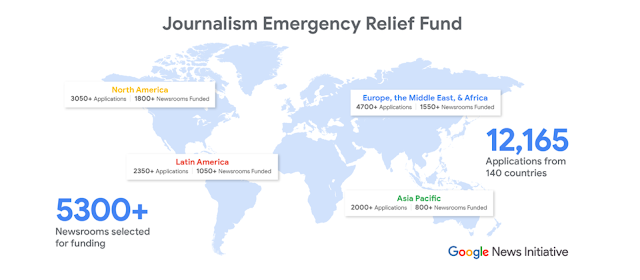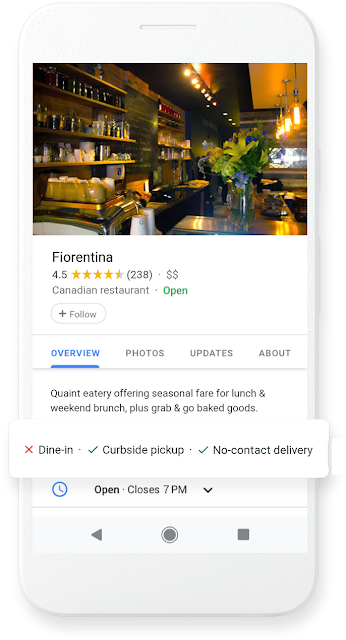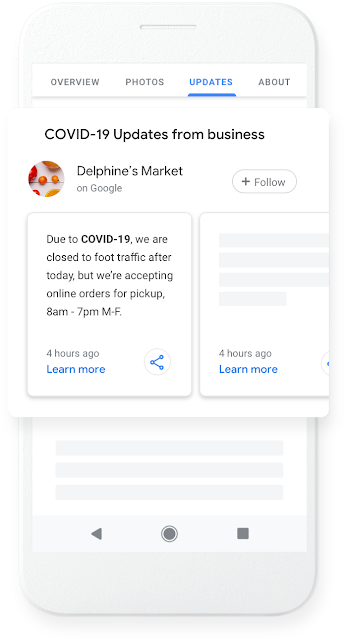In just two weeks we received more than 12,000 applications from 140 eligible countries, with 90 percent of those applications from newsrooms of less than 26 journalists. We reviewed each application against a set of criteria: publications operating locally, serving a specific geographic community and using the money to continue doing so. More than 300 Googlers joined forces to check the submissions and across the world we held dozens of webinars and office hours to answer questions and guide people through the process.
About 50 percent of the applications didn’t meet the publicly established criteria. Reasons varied from not producing core news (i.e., lifestyle or sports news) to employing less than 2 journalists. The goal was to be as inclusive as possible while sticking to the eligibility rules. We still have a small percentage of projects to review but below our teams have provided a snapshot of some of the recipients and how they plan to spend the funding.
Canada:
As we read their stories, we were struck by the number of news organizations in the U.S. and Canada keeping their communities informed with fewer than 10 full-time employees. As small businesses, many applicants are trying to figure out how to keep the lights on, literally and figuratively. They’re passionate about providing high-quality journalism, and it’s an honor to support them during such a critical point:
- The Discourse Cowichan serves a rural region on Vancouver Island, B.C., including Cowichan Tribes, the largest First Nation in the region. It will increase reporting capacity to cover the impact of COVID on vulnerable communities. This week also marks the launch of Indiegraf, a network of journalist-entrepreneurs and independently-owned digital publishers sharing resources to serve their local communities sustainably. Google News Initiative provided seed funding to the network and several of its members received support through JERF. "Entrepreneurship and innovation are urgently needed to fill gaps in local news that have widened as a result of COVID-19,” said Erin Millar, co-founder and CEO of Indiegraf and The Discourse. “I'm grateful to Google for recognizing the essential role that small, digital publishers and startups play in serving local communities."
- CEO Jeff Elgie, who oversees Ontario-based Village Media, says: “Google has been an incredibly important partner in the development of our business. From their business productivity tools to platforms that run everything from our analytics to our ads, we simply couldn’t do it without them. To see them launch the Journalism Emergency Relief Fund in these difficult times further proves to me their sincere interest in supporting the industry.”
Europe, the Middle East, and Africa: Mark Peters, Director, EMEA Partnerships
We received applications from 88 countries, and so far we’ve offered funding to more than 1550 publishers, each demonstrating the diversity and strength of local communities and the journalists that continue to serve them through the crisis.
- Mediacités’ (France) fact-checking tool “Veracités” has seen a huge increase in questions from local readers but can currently only answer 10 percent of them. The fund will allow them to invest in the tool and answer more peoples’ questions.
- Eco di Bergamo (Italy) Data journalism techniques have helped local communities understand what’s happening in the Bergamo area which suffered heavy losses during the crisis. Funding will be used to increase investment in new means of production (video, audio, photo, data) to give readers a deeper more analytical knowledge of what’s happening in their territory.
- Bihoreanul (Romania) intends to provide information necessary to fight the spread of COVID-19, and talk about the consequences of the pandemic to its readers.
- Rochdale online (UK) will keep their journalists working during the crisis. They’ll focus on helping the community understand the latest advice on COVID-19 and promote the work of local businesses, charities and volunteers.
- Baraka FM (Kenya) will focus on on-air campaigns to encourage listeners to prevent the spread of COVID-19. They’ll buy personal protective equipment to keep reporters safe when conducting interviews and give emergency stipends to reporters who’ve traveled to cover special reports.
Asia Pacific: Rohan Tiwary, Head of Media, News & Entertainment Partnerships,APAC
Asia Pacific has dealt with COVID-19 for longer than any other region—since January, in some places—so we know how urgently this support is needed. When we looked at the more than 2,000 applications, we considered Asia Pacific’s enormous diversity—not just across ethnicities, religions and languages, but also in terms of the news landscape. We’re supporting more than 800 news organizations in 30 countries and territories, a few examples below.
- The Murray Pioneer (Australia) will set up two online meeting rooms so they can communicate with remote journalists, local governments and interest groups. Their advertising department will also maintain virtual contact with clients and coordinate campaigns more effectively.
- Saitama Shimbun (Japan), a 75-year old newspaper covering the Saitama prefecture, plans to detail the impact of the pandemic to preserve a record for future generations.
- Suara Surabaya (Indonesia) goes beyond being a news portal, allowing readers to submit complaints like a public service hotline and working with stakeholders to find solutions. They will use funding to bridge cash flow impacted by COVID-19.
- Minnambalam (India), a Tamil language publication from Chennai, will be able to keep their newsroom going, the funding giving them the confidence and financial support needed to carry on with their work.
- East Mojo (India), a digital-only news organization, plans to allow journalists to go to remote parts of Northern India to shed light on the impact of COVID-19 once the country’s lockdown is lifted.
Latin America: Camilo Gomez - Online Partnerships Group Lead, LATAM
The process behind reviewing each of the 2,000+ applications in the region was an opportunity to connect with the amazing journalism and stories that support local communities.
- Agencia Amazonia (Brazil) will support Project #CoberturaCovid19Amazônia, which investigates the socio-cultural impact of the coronavirus on traditional populations in the Amazon region, giving priority to stories about indigenous, quilombolas and riverside dwellers.
- El Colombiano (Colombia) will maintain the quality and resources that characterize the journalism of Medellin newspaper (the second most important city in the country).
- La Discusion (Chile) will help finance an integrated radio-digital platform, developing informative, interpretive and opinion content across a variety of subjects like health, minorities, education, and sports etc that have been affected by COVID-19.
- El Imparcial (México) will drive their strategic business plan, which includes improving multimedia content, newsroom training and growing their community.
Today’s news builds on a number of other efforts we’ve recently made in light of the pandemic. The GNI will announce more in the coming weeks and of course continue working to help the industry towards a more sustainable future in an ever increasingly digital world.





